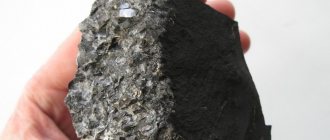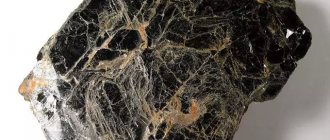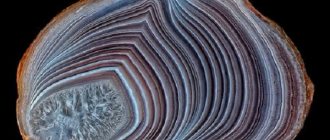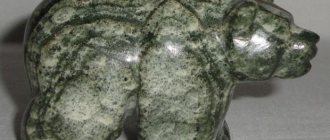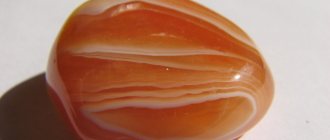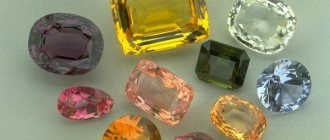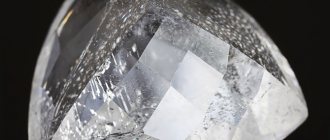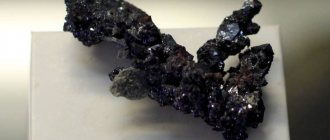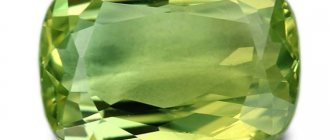The mineral is popular and belongs to the mica group. The phlogopite stone has significant properties and is used in industry and cosmetology, but its effect on different zodiac signs has not been studied. Translated from Greek, it sounds like fire. The name fully justifies itself, since in the rays of the sun its edges resemble fiery flashes.
The name of the stone was given at the end of the 19th century by Breithaupt, and today it has taken root well in the scientific world.
Chemical composition
Chemical composition (in%): K2O from 7.0 to 10.3, MgO from 21.4 to 29.4. Al2O3 FROM 10.8 to 17 (according to the formula it should be 12.2), SiO2 from 38.7 to 45.0 (according to the formula it should be 43.2), H2O from 0.3 to 5.4, F to 6. The most commonly present impurities are FeO up to 9%, BaO up to 2.5% (baryophlogopite), Na2O up to 2%, as well as Fe2O3, sometimes MnO, CaO, Cr2O3, NiO, etc. The variety with a MnO content of up to 18% is called manganphlogopite (does not contain fluorine). The titanium-rich variety is called titanphlogopite. TiO2 obviously replaces the Mg[OH]2 group, since the sum of OH + F in molecular terms is half that expected for micas according to the chemical formula. The composition of phlogopite is sometimes complicated by a large number of gas inclusions (H2, CO, CO2).
Crystallographic characteristics
Syngony. Monoclinic.
Symmetry class . Prismatic - 2/m.
Axle ratio. 0.577: 1: 1.112; β =100°12′.
Crystal structure
Main forms:
The crystal structure of micas, as already indicated, is characterized by the fact that aluminum-oxygen tetrahedra (in the ratio Al : Si = 1 : 3) participate in the layers of silicon-oxygen tetrahedra. As a result, a residual negative charge arises between three-layer packets having the formula Mg3[Si3AlO10][F, OH], which is compensated by the monovalent cation K1+. Unlike other micas, in phlogopite, Mg ions are located inside layered packets between two aluminum-silicon-oxygen layers in all places of six-fold coordination. As in all micas, the layered packets lying one above the other are slightly displaced relative to each other, which determines the general monoclinic system of crystals. Detailed studies have shown that phlogopites belong to the type of single-layer 4-mica
How to distinguish
They offer glued plastic under the guise of a mineral.
The properties of phlogopite allow you to distinguish the imitation:
- Layered structure.
- Elasticity: the plates are easy to bend.
- The lighter does not deform under fire.
The fake doesn't bend well; under a magnifying glass you can see that the layers are glued together. The fire melts.
You can distinguish the origin visually. When describing a natural cabochon, they use the terms “foggy haze”, “chaotic harmony of stains, overflows”.
Form of being in nature
Phlogopite crystal Baikal region Slyudyanka
The shape of the crystals is tabular (pseudo-hexagonal), short-prismatic, sometimes truncated-pyramidal. The crystals are often roughly formed with pronounced parallel shading on the lateral faces. In shape they are indistinguishable from biotite crystals.
Doubles are common. In general, mica twins can be formed according to various laws. Most often there are those in which the twin plane is a plane perpendicular to (001) and passing along the (110) : (001) edge. Typically, individuals grow together along planes perpendicular to (001), so that the planes of cleavage pass from one individual to another without interruption. This is the so-called mica law of twinning. According to the same law, tees are also formed (a third grows to two individuals). Often in such tees, individuals germinate each other. In them, they often have a feathery structure relative to twin sutures, due to the fact that rectilinear thin folds or roughly pronounced strokes are located perpendicular to the (110) : (001) edge. Another law is called the chlorite law; in this case, the twin plane is (001).
Aggregates Dense, leaf-plate, scaly.
Breed cost
In past centuries, the price of mica was in the range of 15–150 rubles. The cost increased with the underground mining method and depended on the rarity of the mineral and the distance between the buyer and the deposit.
Now the same criteria influence the price. Mica slate is sold from 100 rubles per stone. Collectible pieces start at $100. The price of the powder varies from 20 to 300 rubles per package.
Jewelry and products are priced in euros. Depending on the complexity of the work, they can be purchased for 5–6000 euros.
The mineral is valued by magicians, cosmetologists, manicurists, color therapy doctors, and folk craftsmen. Quite accessible in terms of availability and price.
Sources
- https://nataly-moda.ru/podelochnye-kamni/slyuda-kamen.html
- https://FB.ru/article/157197/slyuda—eto-chto-za-mineral-opisanie-i-svoystva-slyudyi
- https://vericon.ru/talismany/slyuda-eto.html
- https://zauber-russ.ru/kamni/slyudit-kamen.html
- https://uglevodorody.ru/publ/slyuda-osobennosti-minerala-i-svoystva-sposoby-dobychi-primenenie
- https://obskaya.ru/kamni/slyudit-kamen.html
- https://TokyoStreet.ru/podelochnye-kamni/slyuda-kamen-opisanie.html
- https://ArtMariev.ru/volshebstvo-kamnej/kamen-slyuda.html
- https://jgems.ru/podelochnye/slyuda
- https://zakamnem.ru/vidy/slyuda-eto
Physical properties
Optical
- The color of phlogopite is light, yellowish-brown or reddish-brown, less often colorless, silvery, sometimes with a greenish tint; dark brown in thick plates.
- The line is white.
- The luster is glassy, on the cleavage planes it is pearlescent with a golden or copper tint. The phenomenon of asterism is often observed, which is expressed in the fact that when examining the plate against the flame of an artificial light source, a bright six-rayed star is discovered.
- Transparency. Transparent, translucent.
Mechanical
- Hardness 2-3.
- Density 2.70-2.85.
- The cleavage is very perfect along {001}; imperfect cleavage appears along {110} and (010}, which are slip planes. These planes are clearly visible in the so-called impact figure, which is obtained for all micas on the (001) cleavage plane if a blunt needle is placed on it and sharply hit with a hammer As a result, systems of three intersecting lines diverging from the point of impact are formed, like a six-rayed star. Two rays are almost exactly parallel to the edges of the prism {110}, and the third, longest line is parallel to the plane of symmetry. If on a thick plate placed on something soft, press not with a needle, but with a ball or the rounded end of a cylindrical stick, then a pressure figure is formed, i.e., a six-rayed star with ray directions perpendicular to the ribs. These directions, compared to the impact figure, are rotated by 30°. Both figures are characteristic of all mica-like minerals .
- Thin sheets have elasticity.
Chemical properties
Decomposes in acids, especially sulfuric acid.
Other properties
It has very high ohmic resistivity and electrical insulator properties.
Artificial production of mineral
It is artificially obtained by crystallization of a fluorine-containing silicate melt corresponding to the composition of phlogopite by adding CaF2 to it (D. P. Grigoriev). In this way it was possible to obtain crystals up to 1 cm in diameter.
Diagnostic signs
Similar minerals. Muscovite, paragonite, biotite.
Associated minerals. Calcite, dolomite, serpentine, apatite, diopside, vesuvian, etc.
Light varieties of phlogopite are practically indistinguishable from muscovite in appearance, but the optical constants are different: phlogopite , like all other magnesium-iron dark micas, is optically almost uniaxial, while muscovite is clearly biaxial and has a large angle of optical axes.
It differs from biotite in its lighter color.
Where is it used?
The main consumers of phlogopite are industry and the military-industrial complex. The most beautiful examples go to collectors and decorators.
Industry
Phlogopite mica does not conduct current even at extremely high temperatures. It is flexible and refractory.
Thanks to these properties, the mineral has found application in industry:
- It is purchased by manufacturers of electrical insulation for the nuclear industry, military-industrial complex, aviation, instrumentation, and mechanical engineering.
- They enrich solutions used in drilling oil and gas wells.
- The powder is added to varnishes, coatings, and glass melts to impart fire resistance and beauty.
- Sight glasses are cut from transparent plates in melting furnaces and Geiger counters.
- The weathered mineral becomes vermiculite. It is valued by farmers as a substrate for seedlings. For builders, this is an environmentally friendly filler for heat and sound insulation slabs.
Phlogopite is found in any household electrical appliance: kettle, toaster, iron, coffee maker.
Transparent phlogopite has the properties of an ideal insulator. This is what electrical manufacturers buy. Iron impurities reduce the dielectric properties of non-ferrous raw materials.
Raw materials from the Kovdor deposit are used more often: in terms of reserves and characteristics, they are unrivaled in the world. An enriched, classified, packaged product comes from the local mining and processing plant. This is a national treasure of Russia, a component of the federal import substitution program.
Other areas
Phlogopite is classified as ornamental, so it is not used by jewelers.
Master stone-cutters create an assortment of products from it:
- Cabochons, beads for jewelry and amulets: pendants, earrings, rings, necklaces.
- Mineral plates are used to decorate furniture, panels, boxes, and tabletop appliances.
Collectors are buying up specimens with ingrowths of other stones and specimens with a bronze tint and mother-of-pearl reflection.
Origin and location
Quite often found in contact-metasomatic formations of willows in pegmatite veins cutting dolomitized limestones or other magnesian rocks poor in silica and iron (for example, serpentinites). Typical companions of phlogopite are diopside, forsterite, spinel, dolomite, calcite, feldspars, scapolites, etc.
Also common in metamorphic rocks (schists), usually in association with relatively iron-poor minerals. Without measuring optical constants, it can easily be mistaken for muscovite.
Mineral Change
Tetraferriflogopite with olifin and calcite Kola Peninsula
With the superposition of later processes, phlogopite is sometimes replaced by chlorites, sometimes it turns into talc.
Under conditions of intense chemical weathering, hydration occurs, in some cases with the appearance of brown spots of iron hydroxides, and ultimately transformation into a clay product.
Are there jewelry with mica?
Mica is used to decorate not only figurines, boxes, floor lamps or other interior and household items. It is used for the restoration of products made from expensive wood and ivory. Jewelers create beads, earrings, and pendants with the mineral. But masters call stone differently.
The most commonly used varieties of muscovite are:
- roscoelite (red, black, brown, green);
- fuchsite (bright green);
- sericite (white, silver);
- gilbertite (light green).
They are not available in jewelry stores. Jewelry can be ordered or found from folk craftsmen. They are sold online and at crafts fairs. Products are short-lived and easily damaged.
How to care for a mineral
Products made from mica are quite fragile, so they must be protected from impacts and friction. It is better to store jewelry in separate boxes with a soft backing. Do not get it wet or leave it in the bath or damp places. To remove dirt, wipe with a damp cloth and immediately blot with a paper napkin. Dust is brushed off with a synthetic broom.
Place of Birth
The Slyudyansk phlogopite deposits are located near Lake Baikal, near the station. Slyudyanka, Zabaikalskaya railway e. In a genetic connection with granite intrusions, numerous cutting pegmatite veins and metasomatic formations were formed here among a complex complex of crystalline schists, gneisses and marbles. Phlogopite-bearing mineral bodies are usually subordinate to pyroxene-amphibole gneisses and are often found in groups. The structure of such veins is quite complex. Diopside-phlogopite formations develop in the side rocks (regardless of their composition). Large-crystalline phlogopite is usually associated with diopside, scapolites, calcite, apatite and other minerals. The crystals often have barrel-shaped shapes, often with a sharp end, sometimes measuring up to 1.5 m in length. According to the color, the following varieties of phlogopite crystals are distinguished: 1) non-retin or with a yellowish tint, 2) silvery-white, mainly among limestones, 3) amber among aplite-like gneisses, 4) cherry or amber-red, 5) dark brown, sometimes with a golden tint , 6) dark green and 7) almost black among pyroxene-hornblende and biotite gneisses. When weathered, ferruginous phlogopites lighten and turn blue. Inclusions of calcite, scapolite and diopside are often observed among phlogopite crystals, and under a microscope, rutile is also identified in the form of the finest needles (saguenite), etc. Similar phlogopite deposits are common in the Aldan region of Eastern Siberia.
Phlogopite deposits in the province of Ontario (Canada) are found in approximately the same conditions in the form of veins and irregularly shaped nests. Phlogopite occurs in association with calcite, diopside and apatite in a wide variety of quantitative ratios. Phlogopite crystals reach 2 m in diameter. Amber coloration of phlogopite is the most common. Deposits of the same type are known in Madagascar, Ceylon, India, Korea, etc.
Phlogopite is a typical mineral of kimberlites (Yakutia), although many researchers consider it to be more recent, metasomatic. Phlogopite phenocrysts are known in some lavas (East Kimberley Australia)
Phlogopite mica, formed during the intrusion of granite pegmatites into hyperbasites, are known in the Emerald Mines (Sverdlovsk region, Russia). Vein-like mica were established in talc-carbonate rocks when exposed to an ultramafic granite massif (Kuznetsk Alatau)
History of origin
The origin of quartzite is very ancient. The first tools made from it were discovered during archaeological excavations at established places where the first people lived. For example, during excavations that were carried out in Mesopotamia, tools were discovered, the age of which, as was later established, was about seven thousand years. Quartz also had a place in the works of ancient philosophers: Theophrastus and Pliny the Elder. Oddly enough, quartzite is very popular.
The main deposits of the stone are Russia, the USA, African countries and Eastern European countries. Since quartz is 90% of the composition of most rocks, it is rightfully considered the most common mineral among all others.
Quartz is extremely popular among professional collectors. And its raw crystals can very often be found as souvenirs.
It is used in the manufacture of jewelry, which can be purchased even by not very wealthy people. But there is an exception to this rule - rose quartz. It stands on par with precious stones or is used in the same piece of jewelry along with gold. Such jewelry becomes the most valuable and undoubtedly, their price tags are worth quite a large sum, and the price is sometimes so high that even diamond jewelry is lower.
Practical use
Phlogopite is used industrially in the same way as muscovite, but for some purposes it is preferred over muscovite. It is used in electrical switches because it wears out at the same rate as copper segments. It has great heat resistance and can withstand temperatures up to 1000oC. For industrial use, large crystals of phlogopite are obtained in laboratories, in which all OH ions are replaced by F, but the natural material is less expensive. The main suppliers of natural phlogopite are Canada and Madagascar.
What is
Phlogopite is a type of mica of igneous, metamorphic or metasomatic origin:
- Like any mica, phlogopite is translucent, layered, and flexible. But the layering is hypertrophied, the agglomerate looks like a child’s collapsible pyramid or the pages of a “book” - square, rhombic, hexagonal.
- Pure phlogopite is colorless; impurities give it white, yellow, reddish, and brownish tints.
Usually the agglomerates are not large; samples several tens of centimeters long are considered unique.
The name under which the mineral entered history and scientific nomenclature was invented at the end of the 19th century by the German mineralogist Johann Breithaupt. It has Greek roots and means “fiery.”
